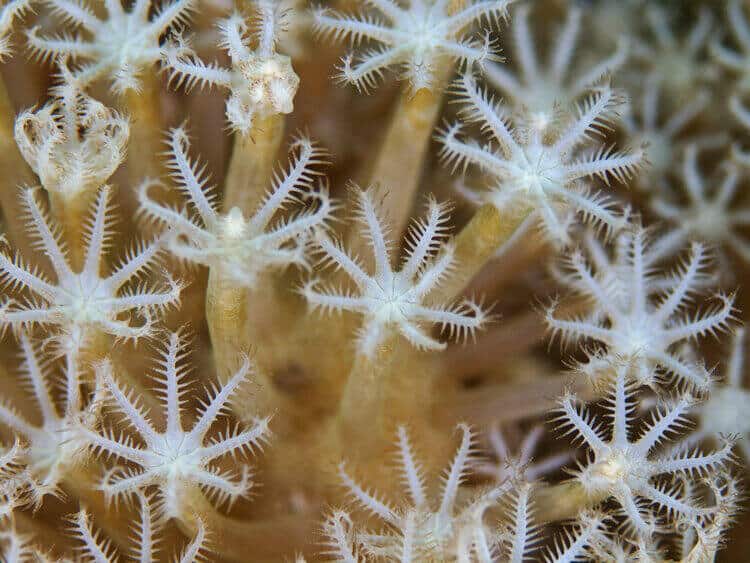_XeniaSpWRS_Ap8R.jpg)
The true Soft Corals are beautiful corals, where each polyp has side branches that give it a feathery look!
The hobbyist idea of “soft corals” refers to the true Soft Corals. The true soft corals consist of many beautiful species that occur in all the colors of the rainbow and come in all sorts of attractive shapes. Soft Corals are quite dynamic in the reef aquarium. Besides being very attractive and colorful, they can change form and create a lively motion. They will expand and deflate their bodies as well as extend and retract their tentacles.
To the hobbyist soft corals are those that lack a hard skeleton, like the hard corals or stony corals. The true soft corals also don’t have a tough skin like the Leather Corals. This is basically what we are listing in this section. There are many well known favorites that make great soft corals for beginners. Leather Corals, another group of soft corals, also make great beginner corals.
Besides the well-known varieties, there are hundreds of different types of soft corals. These include Gorgonians and other unique Octocorals like the Blue Coral, Organ Pipe Coral, Green Star Polyps, and the Sea Pens. Each of these beautiful corals will have care requirements that are just as diverse as the animals they are; consequently not all soft corals are easy keepers. It is very important to learn about the species you are keeping for a successful reef aquarium.
For information about soft corals see:
Soft Coral Facts and Information – Types of Soft Corals
What is a Soft Coral
They are called “soft” because they do not consist of rigid calcium carbonate skeletons like the hard corals or stony corals do. Soft corals are mostly composed of living tissue. This can be confusing since many ‘soft corals’ are not actually soft. A couple exceptions include such corals as the Blue Coral Heliopora coerulea and the Pipe Organ coral Tubipora musica, both of which produce hard skeletons.
Like the stony corals, soft corals are Cnidarians meaning stinging celled animals. They are also members of the Subclass Octocorallia, known as the Octocorals. These are corals with eight-branched tentacles in their polyp structure. Another characteristic of true soft corals are the side branches of the polyp tentacle, called ‘pinnules‘, which give the polyps a feathery look. Although pinnules are a sure sign of a soft coral, not all soft corals have them..
Soft Corals for Beginners
The soft corals include many easy to care for favorites. Some soft corals for beginners include varieties like:
- Carnation Coral – Dendronephthya sp.
- Finger Leather Cora -l Alcyonium sp.
- Kenya Tree Cora -l Capnella sp.
- Tree Coral –Lemnalia sp.
- Palm Tree Polyps or Glove Polyps – Clavularia viridis
- Pulse Corals –Xenia sp.
- Waving Hand Coral – Anthelia sp.
Leather Corals are also great beginner soft corals, varieties like:
- Colt Coral – Cladiella Sp.
- Common Toadstool Coral – Sarcophyton glaucum
- Yellow Leather Coral – Sarcophyton elegans
- Yellow Toadstool Leather Coral – Sarcophyton tenuispiculatum
- Elephant Ear Coral – Sarcophyton trocheliophorum
- Cabbage Leather Coral – Lobophytum crassum
- Devil’s Hand Coral – Lobophytum Sp.
- Cabbage Leather Coral – Sinularia dura
- Finger Leather Coral – Sinularia notanda
- Flexible Leather Coral – Sinularia flexibilis
Soft Coral Care
Soft corals are favored by reef aquarists and quite a few make great beginner corals. Many readily available species are easy to keep with great success. Provide adequate lighting and a medium to strong current. A protein skimmer and frequent water changes are also very helpful.
Many species live in symbiosis with the marine algae, zooxanthellae. Those that contain zooxanthellae need a lot of light. On the other hand many of them, like the carnation corals, grow on the underside of reef ledges or shaded areas and don’t require light.
Feeding Soft Corals
Soft corals that contain zooxanthellae also derive the majority of their nutrition from it. Most will eagerly accept small foods like brine shrimp and plankton as well. They usually must be fed to survive in the aquarium.
To set up a reef aquarium see:
Reef Tanks – Mini-Reef Aquarium Basics
Featured Image Credit: scubaluna, Shutterstock


Polyp_ClavulariaSpWRS_C1367_vsm.jpg)



_XeniaSpWRS_Ap8R_vsm.jpg)
Coral_AntheliaSpWRG_C702_vsm.jpg)